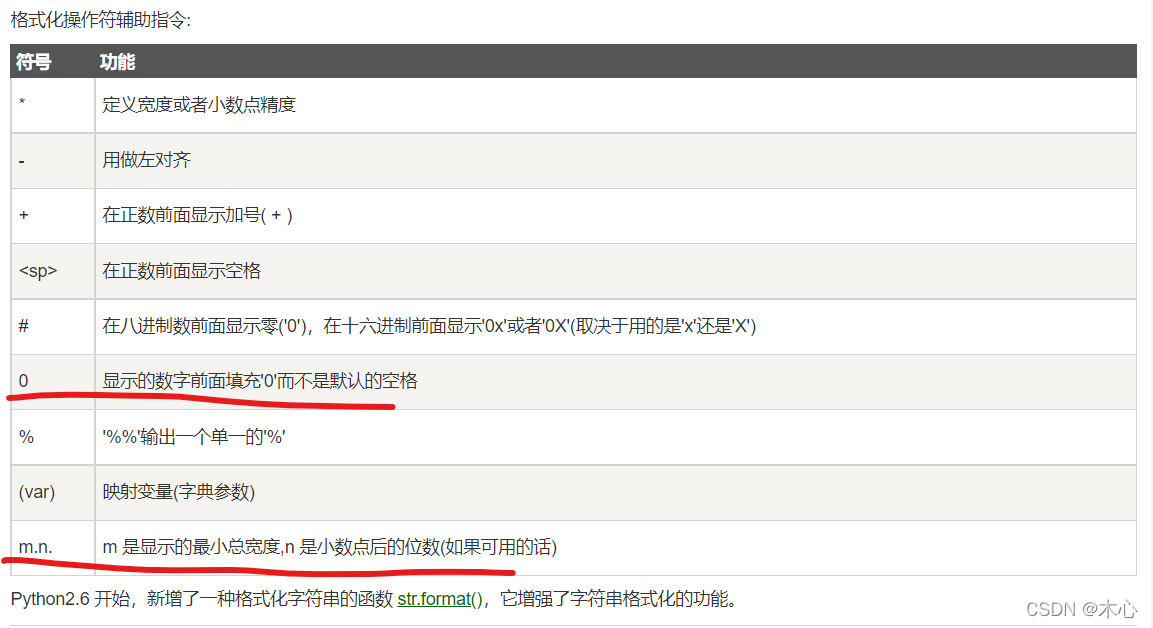热门标签
热门文章
- 1【MySQL进阶之路丨第十五篇】MySQL数据的导入与导出_导入数据库
- 2Centos 8.5 yum安装mysql5.6 基于mysql8.4 yum源
- 3jetson nano上编译与使用西门子PLC通讯库snap7
- 4Android 项目适配64位架构后,腾讯X5内核加载失败解决方案
- 5Ubuntu 18.04 LTS 使用 WordPress 搭建博客 并 部署 CDN 教程_ubuntu搭建cdn
- 6知网上怎么查找被EI收录的期刊?_ei收录期刊怎么查找
- 7[附源码]基于JAVA的智慧养老院信息管理系统1ompa9计算机毕设JSP
- 8Mac vscode 配置c++环境_mac vscode opencv4.2
- 9AIGC从入门到实战:自然语言处理和大语言模型简介
- 10Flutter开发指南
当前位置: article > 正文
Python format 字符串格式化函数_{0:0<8s}".format
作者:繁依Fanyi0 | 2024-06-07 15:40:38
赞
踩
{0:0<8s}".format
Python format 字符串格式化函数
一、简介
从Python2.6开始,新增了str.format(),它增强了字符串格式化的功能。基本语法是通过 {} 和 : 来代替以前的 % 占位符。
二、占位符%表达式方式
1、使用默认位置方式
字符串格式符号用法如下

举个例子:
name = 'sugar'
age = 21
print("His name is %s, and he is %d year old." %(name, age))
- 1
- 2
- 3
结果
His name is sugar, and he is 21 year old.
- 1
其他格式化辅助操作指令如下,其中用的比较多的就是使用0来补零,和控制小数位数的.

举个例子:
price = 23.1999
obj = 'milk'
print("The %s's price is %03f" %(obj, price)) # 前面补三个零
print("The %s's price is %3.0f" %(obj, price)) # 最小总占位长度为3,控制输出0个小数
print("The %s's price is %3.3f" %(obj, price)) # 最小总占位长度为3,控制输出3个小数
print("The %s's price is %5.4f" %(obj, price)) # 最小总占位长度为5,控制输出4个小数
- 1
- 2
- 3
- 4
- 5
- 6
- 7
结果:
The milk's price is 23.199900
The milk's price is 23
The milk's price is 23.200
The milk's price is 23.1999
- 1
- 2
- 3
- 4
2、使用字典的方式
使用方法是在%s之间添加需要通过字典来查找的键值
可以通过字典的键值对来指定格式化元素的位置
D = dict(name='Bob', job='dev')
print('%(name)s, %(job)s' %(D))
- 1
- 2
Bob, dev
- 1
三、format方法格式化方式
字符串format格式化的四种方式
1、使用默认位置方式
格式:string{}.format(x1, x2)
举个例子
price = 23.1999
obj = 'milk'
print("The {}'s price is {}".format(obj, price))
- 1
- 2
- 3
结果如下
The milk's price is 23.1999
- 1
2、使用指定位置方式
格式:string{0}.format(x1, x2)
举个例子
price = 23.1999
obj = 'milk'
print("The {0}'s price is {1}".format(obj, price))
- 1
- 2
- 3
结果如下
The milk's price is 23.1999
- 1
3、使用列表方式
其实这种方式就相当于前两种使用默认位置和使用指定位置的方式,只不过这里需要使用*对列表进行解包,举个例子
price = 23.1999
obj = 'milk'
info = [obj, price]
print("The {}'s price is {}".format(*info)) # 对info进行解包
- 1
- 2
- 3
- 4
结果如下
The milk's price is 23.1999
- 1
4、使用字典的键值对方式
格式:string(key).format(key=value)
举个例子,当然也可以用**对字典进行解包
price = 23.1999
obj = 'milk'
print("The {name}'s price is {pri}".format(name=obj, pri=price))
# 更进一步,对字典进行解包
dic = {'name':'milk', 'pri':23.1999}
print("The {name}'s price is {pri}".format(**dic))
- 1
- 2
- 3
- 4
- 5
- 6
- 7
结果如下
The milk's price is 23.1999
The milk's price is 23.1999
- 1
- 2
5、其他数字格式化的方式

需要注意的是,在:冒号后面指定需要填充的内容,可以使用上述4种格式化方式来对文本格式进行控制,举个例子
price = 23.1999
obj = 'bread'
print("The {}'s price is {:.2f}".format(obj, price)) # 使用默认位置方式,保留两位小数
print("The {0}'s price is {1:.2f}".format(obj, price)) # 使用指定位置方式,保留两位小数
print("The {name}'s price is {price:.2f}".format(name=obj, price=price)) # 使用字典方式,保留两位小数
li = [obj, price]
print("The {}'s price is {:.2f}".format(*li)) # 使用列表解包的方式,保留两位小数
info = {'name':obj, 'price':price}
print("The {name}'s price is {price:.2f}".format(**info)) # 使用字典解包的方式,保留两位小数
- 1
- 2
- 3
- 4
- 5
- 6
- 7
- 8
- 9
- 10
- 11
- 12
结果如下
The bread's price is 23.20
The bread's price is 23.20
The bread's price is 23.20
The bread's price is 23.20
The bread's price is 23.20
- 1
- 2
- 3
- 4
- 5
四、Reference
声明:本文内容由网友自发贡献,不代表【wpsshop博客】立场,版权归原作者所有,本站不承担相应法律责任。如您发现有侵权的内容,请联系我们。转载请注明出处:https://www.wpsshop.cn/w/繁依Fanyi0/article/detail/685980
推荐阅读
相关标签



